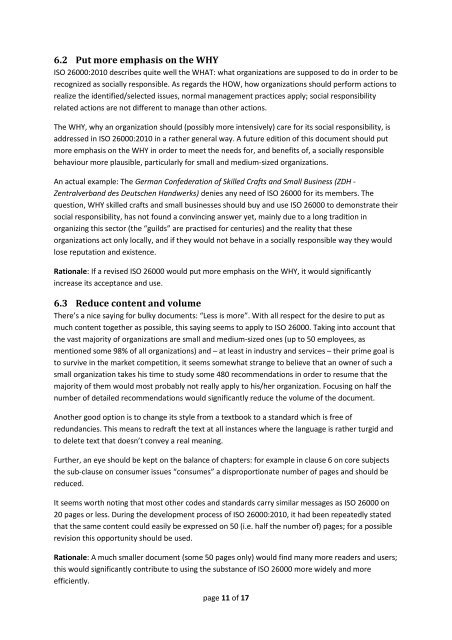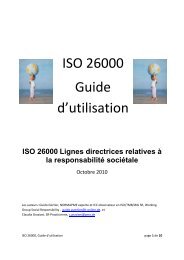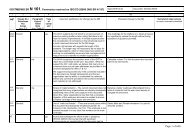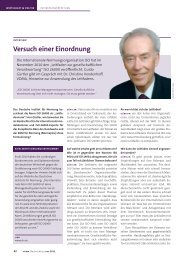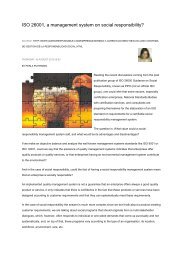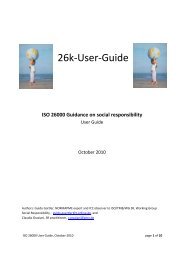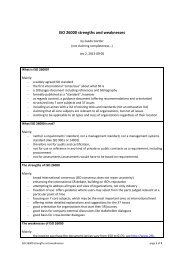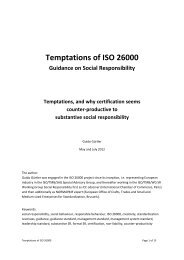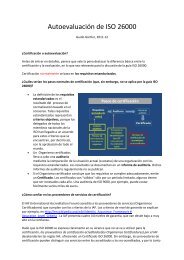download in PDF format - ISO 26000, an estimation
download in PDF format - ISO 26000, an estimation
download in PDF format - ISO 26000, an estimation
You also want an ePaper? Increase the reach of your titles
YUMPU automatically turns print PDFs into web optimized ePapers that Google loves.
6.2 Put more emphasis on the WHY<br />
<strong>ISO</strong> <strong>26000</strong>:2010 describes quite well the WHAT: what org<strong>an</strong>izations are supposed to do <strong>in</strong> order to be<br />
recognized as socially responsible. As regards the HOW, how org<strong>an</strong>izations should perform actions to<br />
realize the identified/selected issues, normal m<strong>an</strong>agement practices apply; social responsibility<br />
related actions are not different to m<strong>an</strong>age th<strong>an</strong> other actions.<br />
The WHY, why <strong>an</strong> org<strong>an</strong>ization should (possibly more <strong>in</strong>tensively) care for its social responsibility, is<br />
addressed <strong>in</strong> <strong>ISO</strong> <strong>26000</strong>:2010 <strong>in</strong> a rather general way. A future edition of this document should put<br />
more emphasis on the WHY <strong>in</strong> order to meet the needs for, <strong>an</strong>d benefits of, a socially responsible<br />
behaviour more plausible, particularly for small <strong>an</strong>d medium-sized org<strong>an</strong>izations.<br />
An actual example: The Germ<strong>an</strong> Confederation of Skilled Crafts <strong>an</strong>d Small Bus<strong>in</strong>ess (ZDH -<br />
Zentralverb<strong>an</strong>d des Deutschen H<strong>an</strong>dwerks) denies <strong>an</strong>y need of <strong>ISO</strong> <strong>26000</strong> for its members. The<br />
question, WHY skilled crafts <strong>an</strong>d small bus<strong>in</strong>esses should buy <strong>an</strong>d use <strong>ISO</strong> <strong>26000</strong> to demonstrate their<br />
social responsibility, has not found a conv<strong>in</strong>c<strong>in</strong>g <strong>an</strong>swer yet, ma<strong>in</strong>ly due to a long tradition <strong>in</strong><br />
org<strong>an</strong>iz<strong>in</strong>g this sector (the “guilds” are practised for centuries) <strong>an</strong>d the reality that these<br />
org<strong>an</strong>izations act only locally, <strong>an</strong>d if they would not behave <strong>in</strong> a socially responsible way they would<br />
lose reputation <strong>an</strong>d existence.<br />
Rationale: If a revised <strong>ISO</strong> <strong>26000</strong> would put more emphasis on the WHY, it would signific<strong>an</strong>tly<br />
<strong>in</strong>crease its accept<strong>an</strong>ce <strong>an</strong>d use.<br />
6.3 Reduce content <strong>an</strong>d volume<br />
There’s a nice say<strong>in</strong>g for bulky documents: “Less is more”. With all respect for the desire to put as<br />
much content together as possible, this say<strong>in</strong>g seems to apply to <strong>ISO</strong> <strong>26000</strong>. Tak<strong>in</strong>g <strong>in</strong>to account that<br />
the vast majority of org<strong>an</strong>izations are small <strong>an</strong>d medium-sized ones (up to 50 employees, as<br />
mentioned some 98% of all org<strong>an</strong>izations) <strong>an</strong>d – at least <strong>in</strong> <strong>in</strong>dustry <strong>an</strong>d services – their prime goal is<br />
to survive <strong>in</strong> the market competition, it seems somewhat str<strong>an</strong>ge to believe that <strong>an</strong> owner of such a<br />
small org<strong>an</strong>ization takes his time to study some 480 recommendations <strong>in</strong> order to resume that the<br />
majority of them would most probably not really apply to his/her org<strong>an</strong>ization. Focus<strong>in</strong>g on half the<br />
number of detailed recommendations would signific<strong>an</strong>tly reduce the volume of the document.<br />
Another good option is to ch<strong>an</strong>ge its style from a textbook to a st<strong>an</strong>dard which is free of<br />
redund<strong>an</strong>cies. This me<strong>an</strong>s to redraft the text at all <strong>in</strong>st<strong>an</strong>ces where the l<strong>an</strong>guage is rather turgid <strong>an</strong>d<br />
to delete text that doesn’t convey a real me<strong>an</strong><strong>in</strong>g.<br />
Further, <strong>an</strong> eye should be kept on the bal<strong>an</strong>ce of chapters: for example <strong>in</strong> clause 6 on core subjects<br />
the sub-clause on consumer issues “consumes” a disproportionate number of pages <strong>an</strong>d should be<br />
reduced.<br />
It seems worth not<strong>in</strong>g that most other codes <strong>an</strong>d st<strong>an</strong>dards carry similar messages as <strong>ISO</strong> <strong>26000</strong> on<br />
20 pages or less. Dur<strong>in</strong>g the development process of <strong>ISO</strong> <strong>26000</strong>:2010, it had been repeatedly stated<br />
that the same content could easily be expressed on 50 (i.e. half the number of) pages; for a possible<br />
revision this opportunity should be used.<br />
Rationale: A much smaller document (some 50 pages only) would f<strong>in</strong>d m<strong>an</strong>y more readers <strong>an</strong>d users;<br />
this would signific<strong>an</strong>tly contribute to us<strong>in</strong>g the subst<strong>an</strong>ce of <strong>ISO</strong> <strong>26000</strong> more widely <strong>an</strong>d more<br />
efficiently.<br />
page 11 of 17


